�
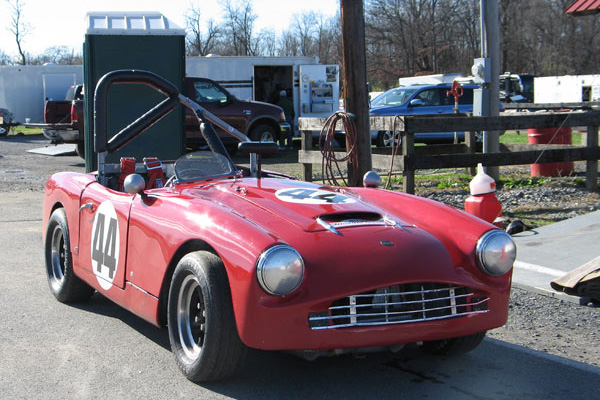
�
Vic Schuster's Turner MkIII Race Car, Number 44
� � Owner: Vic Schuster� City: Kennet Square, Pennsylvania
� Model: 1965 Turner MkIII
� Engine: Ford "Kent" 1500 engine �
�
Turner Sports Cars Ltd.
��
Turner Sports Cars Ltd. produced lightweight sports cars from late 1954 to �
early 1966. Before that, company founder John (Jack) Henry Turner had been an �
enthusiastic racer. He'd already built a diverse assortment of one-off racecars �
and even a couple small engines of his own design. In a 1949 advertisement, �
Turner advertised "castings in light alloy" and "manifolds made to blueprint". �
�
Jack Turner's first racecar was a supercharged MG Magnette that he converted �
into an aluminum-bodied "special" and entered in hillclimb competitions. �
As a confirmed MG enthusiast, Jack Turner comprehended the niche that opened �
when MG discontinued their TD model. Building custom racecars hadn't provided�
a comfortable lifestyle, so he turned his considerable entrepreneurial energy �
to developing an economical sports car based on the Austin A30. �
�
| � Turner Sports Cars featured notably rigid frames constructed of large diameter � steel tubes. (A fiberglass monocoque GT model was the exception that proved � the rule, but only nine Turner GT's were built.) Turner front suspensions � featured dual wishbones and coil springs. Torsion spring rear suspension was � standard equipment, but helical springs were later offered as an option. � Most Turner sports cars came with fiberglass exterior bodywork, although the � first prototype had an aluminum body and some Turners are known to have been � constructed with steel bodies of similar appearance. � | �� | �
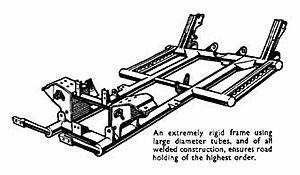 � (Turner promotional illustration)� | �
�
Turner Sports Cars produced both completed cars and unassembled kits (from about �
October 1958). Most of the completed cars were for export to the United States, �
whereas the kits became popular with British enthusiasts who were keen to avoid �
value added tax. It's difficult to determine with precision the company's �
production but the total number was likely between 550 and 650 cars, divided �
over six models as follows: �
�
| Model | Production | Notes | |
| "803" | ~70-80, from 1954 | aka "A30", featured an Austin 803cc engine. | |
| "950S" | ~170, from 1956 | aka "A35" or "950 Sports", featured an Austin 948cc engine | |
| Sports Mk1 | ~40, from 1959 | Austin 948cc or Climax (FWA 1097cc or FWE 1216cc) engines | |
| Sports Mk2 | ~150, from 1960 | Austin, Climax, or Ford (105E 997cc or 109E 1340cc) engines | |
| GT | 9 (1962-64) | Ford 1498cc engines. Fiberglass monocoque construction. | |
| Sports Mk3 | ~100, from 1963 | Ford 1498cc engines. |
�
The per-model production estimates are consistant with Turner's chassis numbering�
system. Some sources quote higher production figures, particularly for the Sports Mk2 �
era, and the difference may possibly be attributed to vague records on the kit-car side�
of Turner's business.�
�
Describing specific differences between Turner models is outside the scope of this �
article, but in terms of styling one can summarize that the "Sports MkI" model brought �
a more streamlined and refined appearance. The MkII and MkIII continued with the same�
basic look. One small distinguishing styling feature of the MkIII was its forward-facing �
hood scoop, but what really made the MkIII model distinctive was its 1.5L Ford engine.
�
�
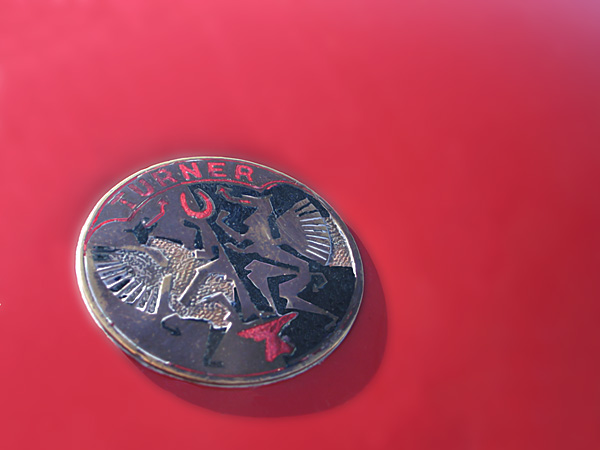
�
Turner Badge. The horseshoe and anvil motifs came about because the company's first premises
�
had been converted from previous service as a blacksmith shop.
�
�
Probably the most famous Turner enthusiast is pop music icon and actress �
Petula Clark. �
You know her big hit: "Downtown". Ms. Clark has owned two Turners. �
�
�
The Turner Register has positively identified about 317 intact cars. That's a remarkable �
number, especially considering that a large proportion of Turner sports cars were actively �
raced. �
�
Turners have competed in various Sports Car Club of America classes. One particularly�
successful Turner MkIII was driven to SCCA Runoff F-Production championship victories by Larry �
Moulton in 1984, 1986, and 1989. Other Turners have participated in the SCCA Runoffs as �
recently as 2006. �
�
�
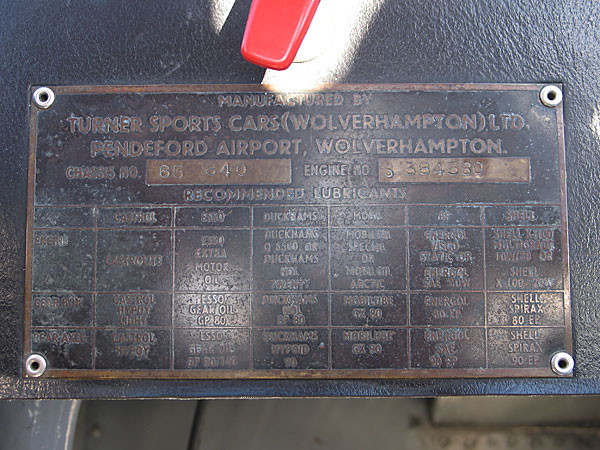
�
Manufactured by Turner Sports Cars (Wolverhampton) Ltd.
�
Pendeford Airport, Wolverhampton.
�
Chassis No. 65 640, Engine No. S 384580
�
�
Enjoying this article? www.BritishRaceCar.com is partially funded through generous support from readers like you!
�
To contribute to our operating budget, please click here and follow the instructions.
�
(Suggested contribution is twenty bucks per year. Feel free to give more!)�
Vic Schuster's Turner MkIII
��
Turner MkIII chassis number 65/640 was originally exported to Fergus Fine Cars of �
New York. Its complete forty-five year history isn't known, but at some point it was �
owned by Dave Dexter, who had purchased it from a friend. During Dave Dexter's time, �
the car evolved into an SCCA F Production racer. It was painted yellow and it wore �
racing number "21". �
�
Another owner, Steve Garrett, had Turner 65/640 prepared for vintage racing in 1999. �
This was Mr. Garrett's third Turner, but the others were earlier models which he raced �
in Vintage Sports Car Club of America events. (Turner MkIII's aren't eligible to race �
in VSCCA events.) Mr. Garrett never raced chassis number 65/640, and it was instead �
sold to Ken Chevas, who did race it. �
�
The Turner has found a great home with Vic Schuster, who has owned it since 2003. �
Vic has raced his Turner MkIII in 35 events in the past six years!�
�
Vic reports that the engine is good to over 7000rpm. Like any competitive race engine, �
it needs to be rebuilt from time to time. Vic has quite successfully completed �
the last three rebuilds himself! He buys parts for the engine from Dave Bean Engineering, �
where Tom Smith is great to work with. He also highly recommends Jess Miller Speed Shop �
in West Chester Pennsylvania for machine work and any sort of fault diagnosis. �
�
One especially interesting feature of chassis 65/640 is that both its front and rear clips �
are hinged for easy access to mechanical components. By pulling hinge pins, all of the�
exterior bodywork can be removed in a couple minutes. This is certainly not a typical �
feature of Turners. It's unknown when the body was modified in this manner.
�
�
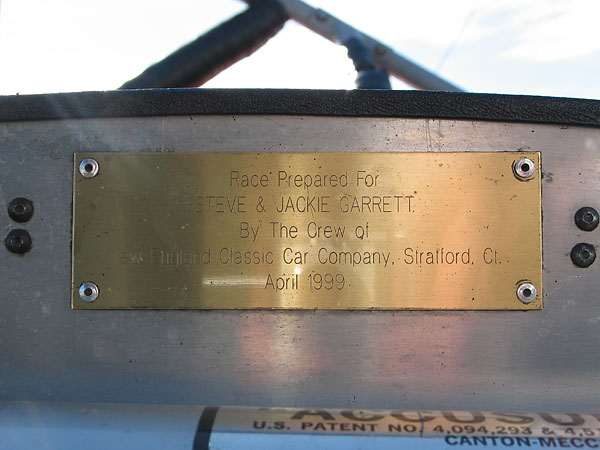
�
Race Prepared for Steve and Jackie Garrett, By the Crew of
�
New England Classic Car Company, Stratford CT. April 1999
�
Please support the sponsoring companies who make www.BritishRaceCar.com possible, including:
� �
 �
�
�
�
Features and Specifications
�| Engine: | �Ford pre-crossflow Kent 1500 engine. �
Ford 2731 crankshaft, Lotus (Ford) 125E connecting rods, and JE forged pistons. �
Approximately 12.6:1 static compression ratio. �
Dave Bean Vintage Race camshaft (0.310" lift). �
Standard rockers and upgraded (steel) posts and shafts.�
Dual Weber 40DCOE-15 carburetors with K&N air filters. �
Pertronix Ignitor breakerless ignition. Lucas Sport ignition coil. �
Pertronix 600 digital rev limiter. �
Wet sump lubrication system. �
Accusump oil accumulator, with electrically operated valve.�
Alloy valve cover. | �
| Cooling: | �copper/brass radiator. Gilmer drive water pump. Electric fan. Serck oil cooler (SHT Ltd. part# 7011217). | �
| Exhaust: | �custon tri-y header. (No muffler.) | �
| Transmission: | �Ford 2000E ("Bullet") 4-speed gearbox with Quaife straight cut, close ratio gears. �
Stock Ford Cortina clutch. | �
| Rear End: | �Austin Healey Sprite rear axle, with 4.2:1 gear ratio and welded differential. | �
| Front Susp.: | �Triumph Spitfire hubs and (Alford & Alder, forged) uprights. �
Triumph Herald steering rack, shortened. Custom fabricated upper and lower A-arms �
in lieu of the Triumph A-arms the car was originally built with. Carrera coilover �
shock absorbers. Custom anti-sway bar. | �
| Rear Susp.: | �custom three-link rear suspension with Koni coilover shock absorbers.�
Panhard rod. Custom adjustable rear anti-sway bar. | �
| Brakes: | �(master) NABCO (Nippon Air Brake) dual circuit master cylinder, � (front) Triumph Spitfire rotors and calipers, � (rear) Austin Healey Sprite drums. | �
| Wheels/Tires: | �Revolution 13x5 aluminum wheels. Hoosier Street T.D. A70-13 tires. | �
| Electrical: | �(switches, left to right) fuel pump, ignition, electric fan, Accusump, fire system, starter (pushbutton). �
Lead acid battery. Gear reduction starter. (No charging system.) | �
| Instruments: | �(center of dashboard, clockwise from top left) �
Stewart Warner fuel pressure gauge (0-16psi), �
Stewart Warner oil pressure gauge (0-100psi), �
Stewart Warner water temperature gauge (100-265F), �
Stewart Warner oil temperature gauge (180-325F).�
(Behind steering wheel, left to right) �
Stewart Warner "Maximum Performance" tachometer (0-10000rpm), �
Smiths speedometer (40-140C). | �
| Fuel System: | �8 gallon ATL fuel cell. Aero Supply Manufacturing Company fuel filter (Assem. 93916-1).�
Dual Bendix fuel pumps. (These are the precursor to the now more widely known Facet pump.) | �
| Safety Eqmt: | �G-force six point cam-lock safety harness. �
Lifeline Zero 2000 foam-extenguishant centralized fire suppression system. | �
| Weight: | �at least 1435#, to suit class requirements. | �
| Racing Class: | �SVRA 3DP. | �
Engine Installation
��
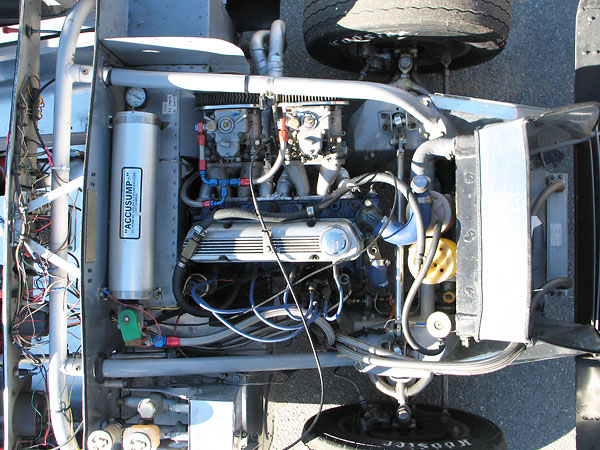
�
Ford pre-crossflow Kent 1500 engine. (Nominally 3.19" bore by 2.86" stroke, for 1498cc.)
�
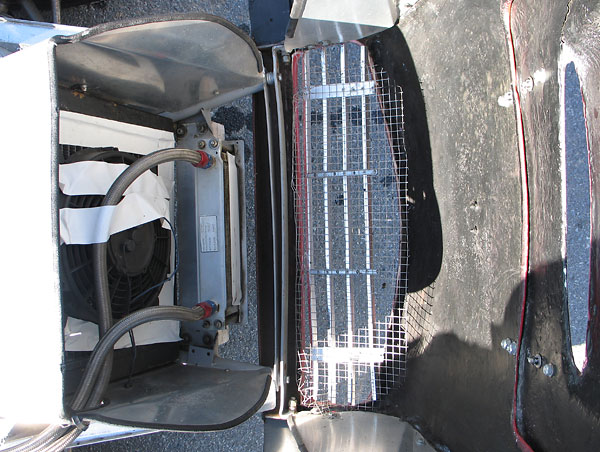
�
We photographed this car in chilly November. Radiator and oil cooler were taped-up for warmer operation.
�
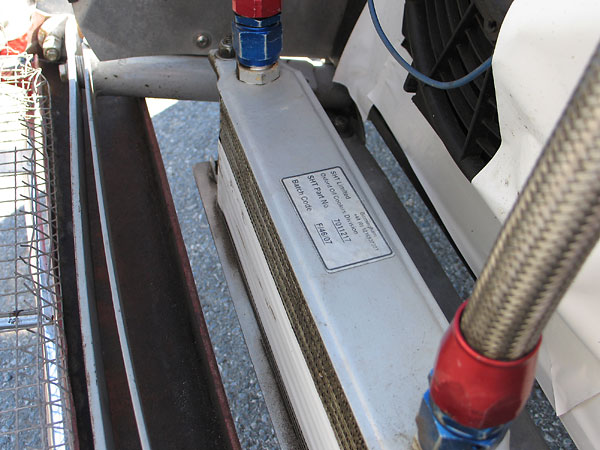
�
Serck oil cooler (SHT Ltd. part# 7011217).
�
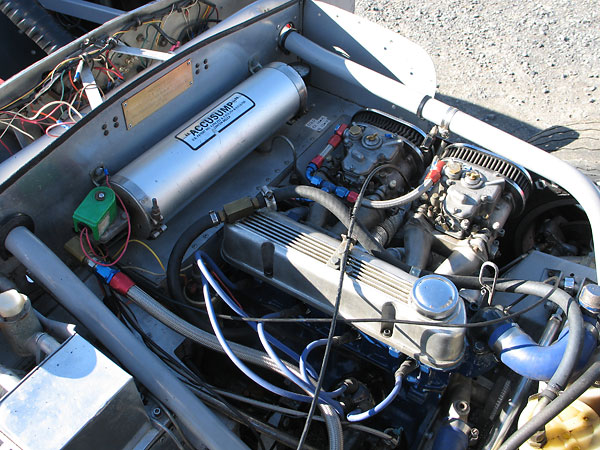
�
Accusump oil accumulator, with electrically operated valve.
�
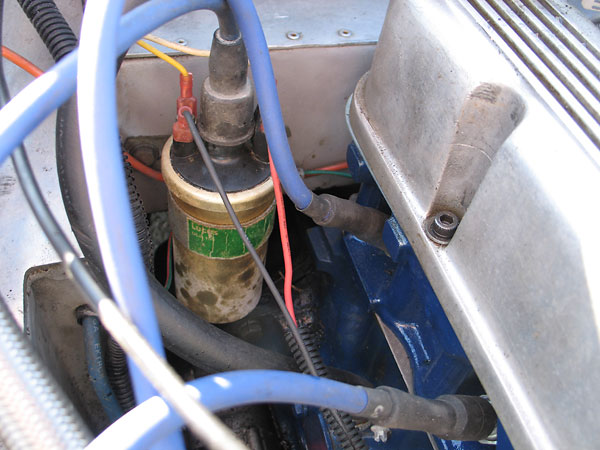
�
Lucas Sport ignition coil.
�
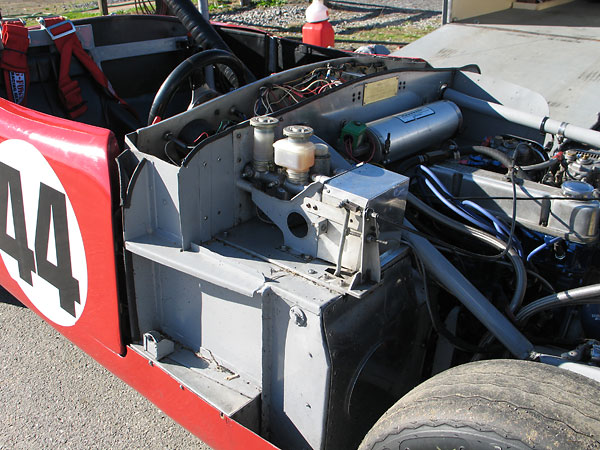
�
NABCO (Nippon Air Brake Co.) dual circuit master cylinder.
�
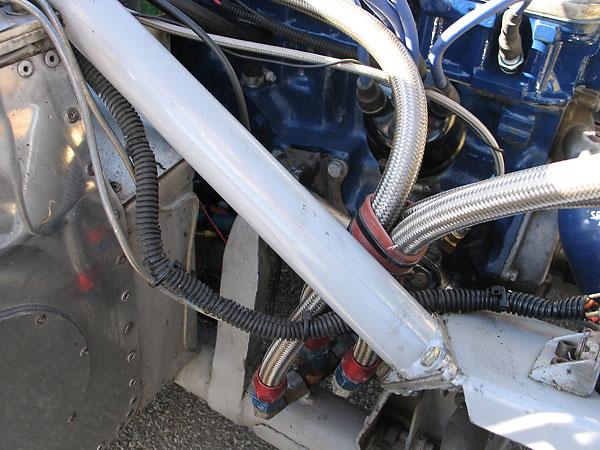
�
Ford Kent engines feature an externally-mounted, combination oil filter and pump assembly.
�
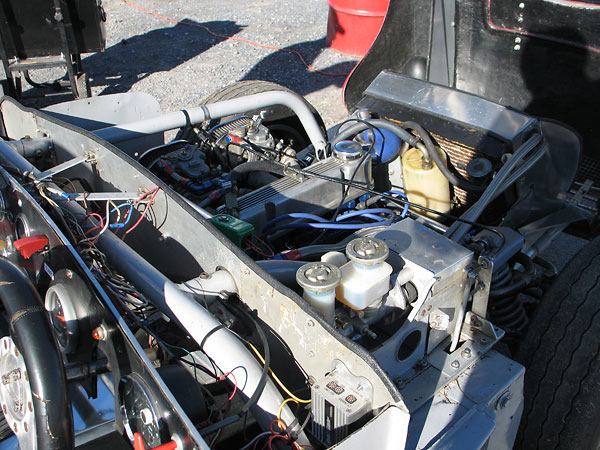
�
A Pertronix 600 digital rev limiter is mounted on the firewall. (At Summit Point, it was set at "7100rpm".)
�
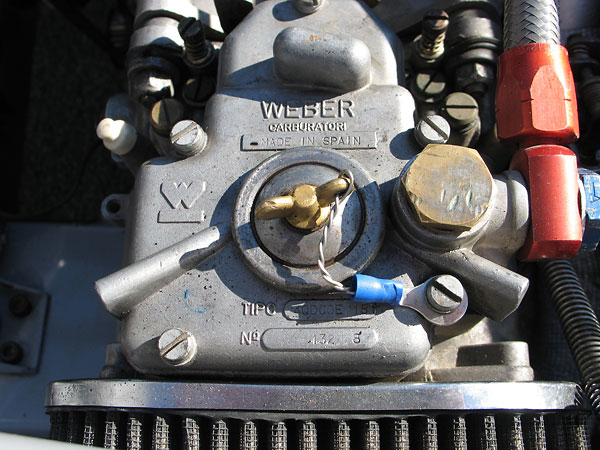
�
Dual Weber 40DCOE-15 carburetors with K&N air filters. (Note: they carbs are marked "Made in Spain",
�
indicating they were produced after production moved from Bologna Italy to Madrid in about 1990.)
�
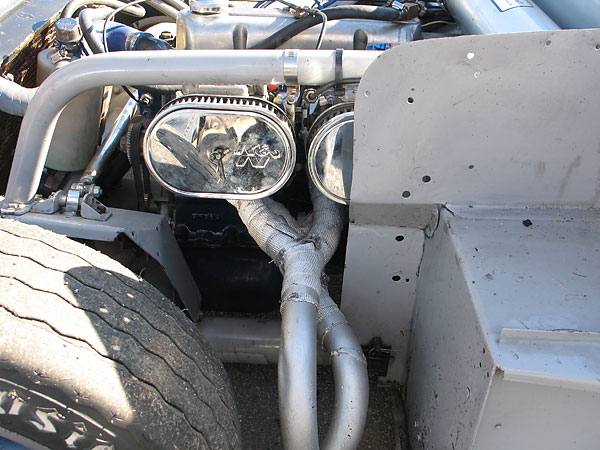
�
Custon tri-y exhaust header.
�
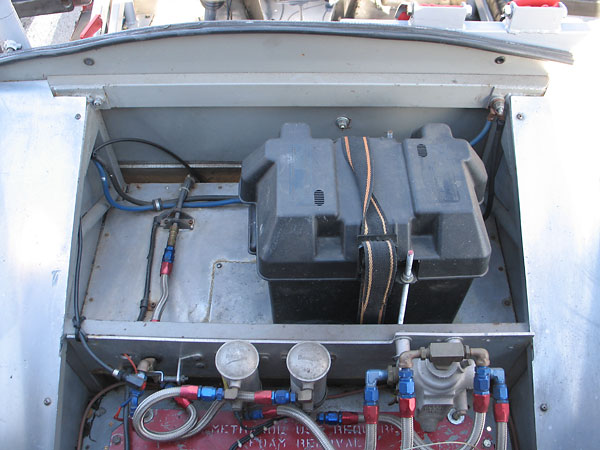
�
A large lead-acid battery is mounted in a marine battery box, behind the seat.
�
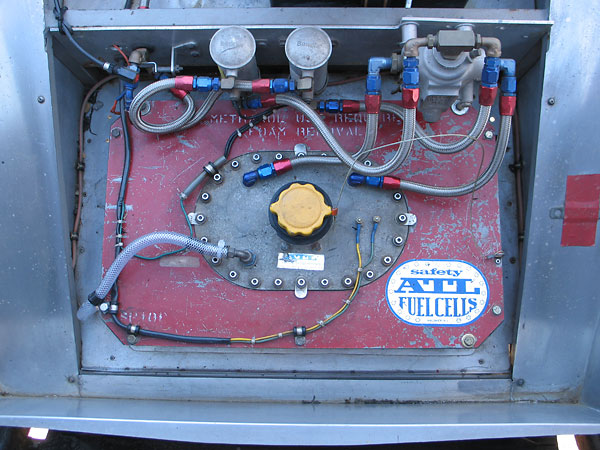
�
ATL fuel cell (eight gallon).
�
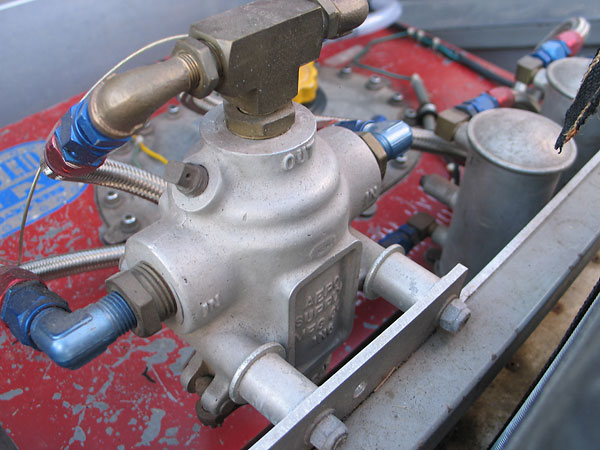
�
Aero Supply Manufacturing Company fuel filter (marked "Assem. 93916-1"). The company was located on
�
Long Island, and claimed to be "The oldest aviation accessory enterprise in the country"... until going
�
out of business in 1931, an apparent victim of the great depression.
�
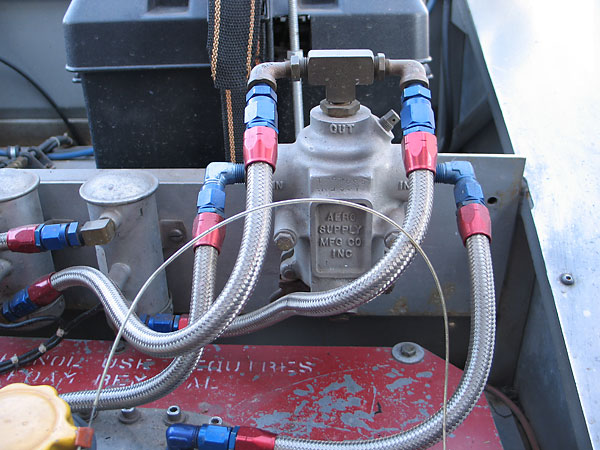
�
Aero Supply Manufacturing Company had been purchased in 1929 by a former General Motors President,
�
John Jacob Raskob, who had resigned from GM to manage the 1928 presidential campaign of New York
�
Democratic Governor Al Smith. How this pre-war airplane part turned up on a 1965 Turner MkIII is a
�
mystery, as is its full functionality. (It's plumbed on the wrong side to work as a pressure regulator.)
�
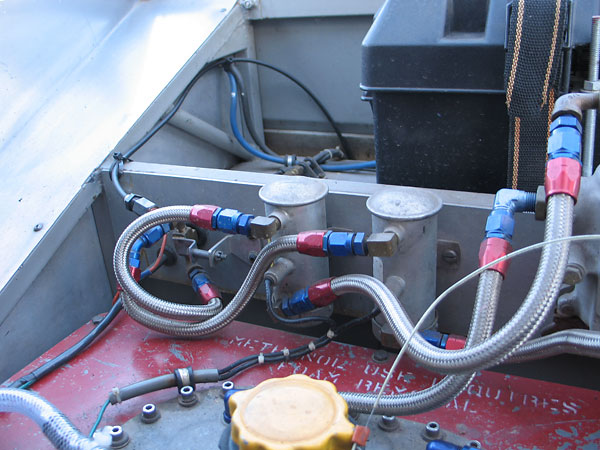
�
Dual Bendix fuel pumps. Pumps of this pattern have been marketed under the "Facet" trademark for years.
�
 �
�
�
�
Front Suspension
��
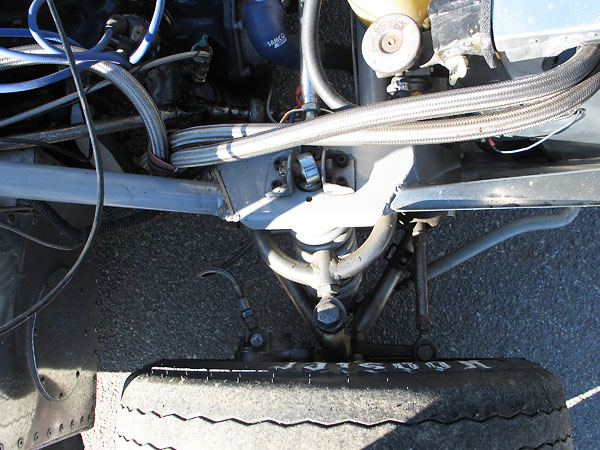
�
Custom fabricated upper A-arm, in lieu of the Triumph A-arm the car originally came with.
�
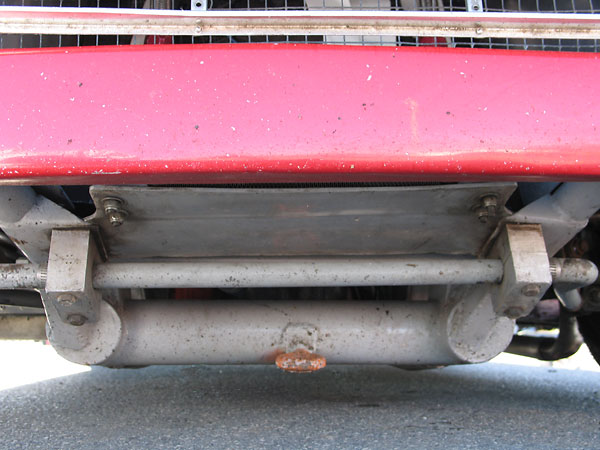
�
Turner's distinctively featured ladder frames constructed of large diameter steel tubes.
�
(Here, a tow ring has been welded to the frame.)
�
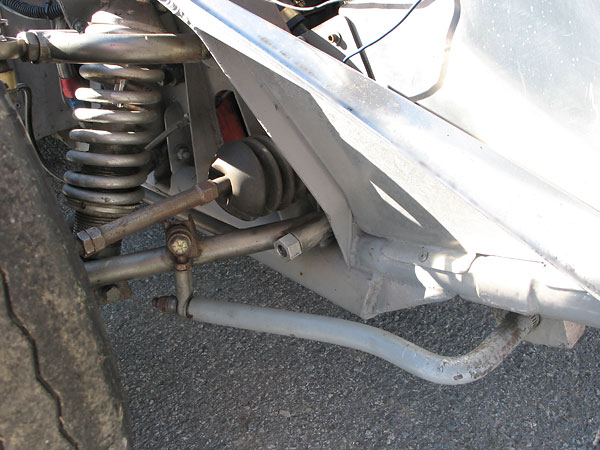
�
Anti-sway bar.
�
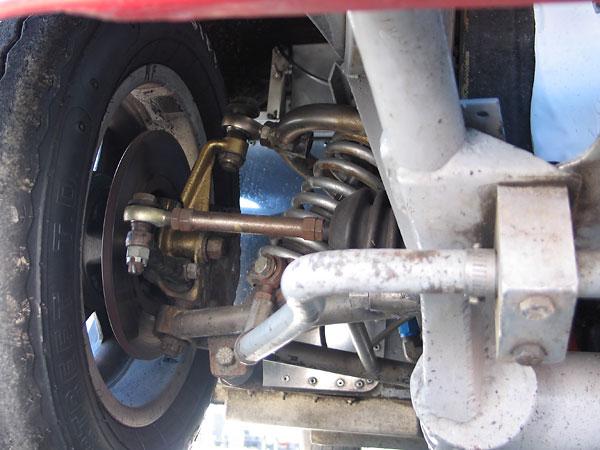
�
Custom fabricated lower A-arms.
�
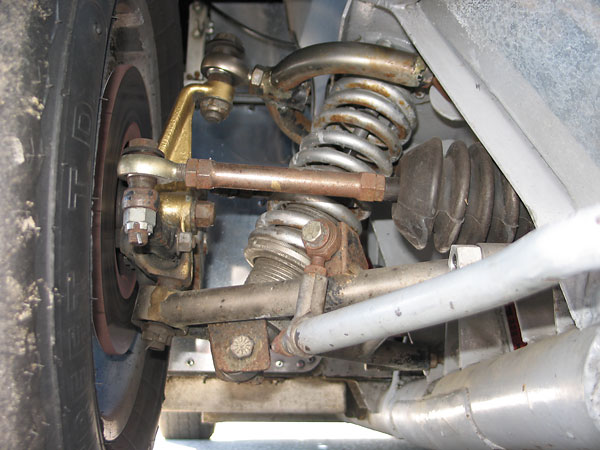
�
Carrera coilover shock absorbers.
�
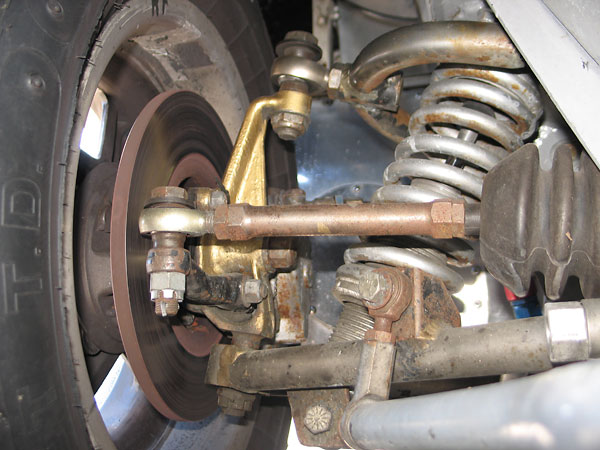
�
Alford & Alder forged uprights have been used on many different models of British sports and racing cars
�
starting with the Standard Eight saloon. Shown here, painted gold, essentially the same part was used on
�
everything from Triumph Heralds to Brabham's 1966 Grand Prix championship winning car. When updated
�
for the Herald, a reinforcing web was added. The Spitfire version has mounting ears for disc brake calipers.
�
�
Rear Suspension
��
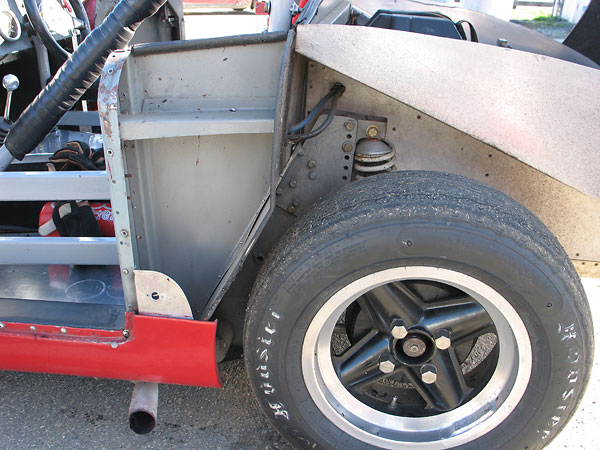
�
Back in the day, Turner offered a choice between helical or torsion springs at the rear. Mounting
�
brackets on the chassis for torsion springs are visible in the photos below. However, here we see how
�
Vic's custom adjustable mounting brackets facilitate use of various length coilover shock absorbers.
�
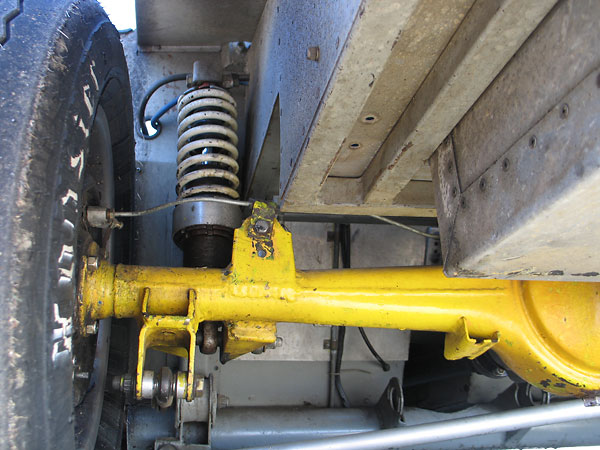
�
Turner originally installed four link rear suspensions. The term "four link" refers to the characteristic
�
trailing radius rods which connect the axle to the chassis: two rods below the axle and two above, but all
�
four rods were mounted as far outboard as feasible. Vic Schuster's MkIII instead features a three link
�
rear suspension, with a single upper radius rod attaching to the chassis above the driveshaft tunnel.
�
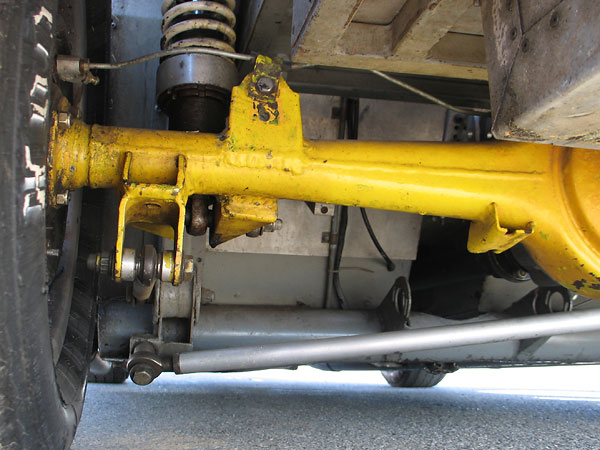
�
Most three link and four link rear suspension are supplemented by transversely-mounted Panhard rods,
�
which restrict side-to-side motion of the body relative to the axle. The Panhard rod shown here is
�
very similar to Turner's original design. It appears to mount to the chassis at the original point.
�
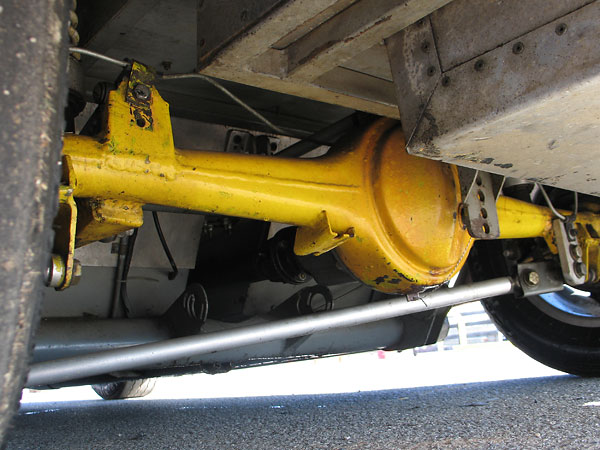
�
At some point in this car's history the Panhard rod was removed and replaced by a Watt's linkage.
�
The SVRA supplemental rules for Turner Sports Cars explicitly approve use of Panhard rods, but they
�
don't mention Watt's linkages. The mounting brackets for a Watts linkage are clearly visible here -
�
two on the axle and one on the chassis behind the differential - but a Panhard rod has been retrofitted.
�
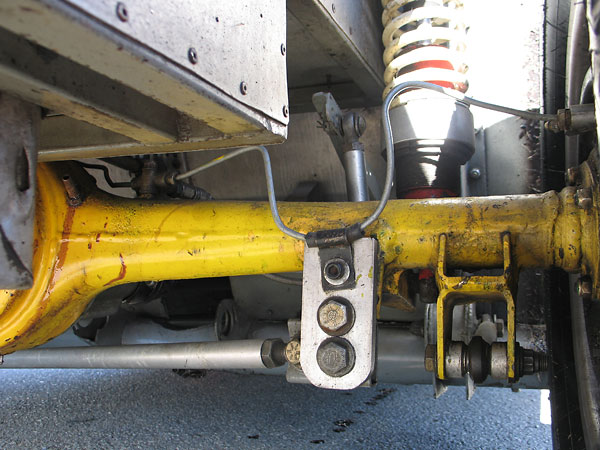
�
Panhard rods don't just restrain sideways movement of the rear axle relative to the car's body.
�
Their vertical location largely determines the suspension's roll center. In Turner installations the
�
Panhard rod is mounted rather low, which achieves a low roll center height. Increased distance
�
from roll center to center of gravity height (i.e. increased "roll couple") would result in
�
increased body roll in turns, but a rear anti-sway bar helps manage that side effect.
�
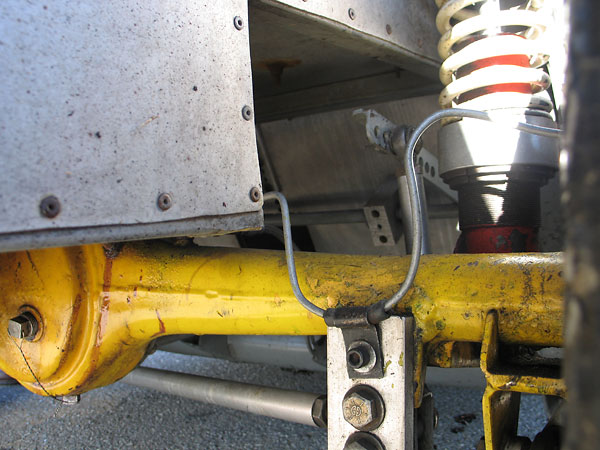
�
The custom anti-sway bar's stiffness is adjusted by changing attachment position along its lever arms.
�
�
Interior
��
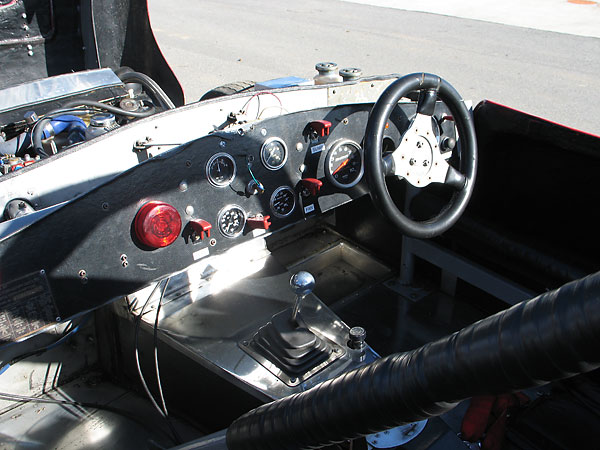
�
At first glance, instrument and switch layout recalls the original Turner MkIII configuration. The
�
instruments are now all by Stewart Warner, except for the original Smiths speedometer / odometer.
�
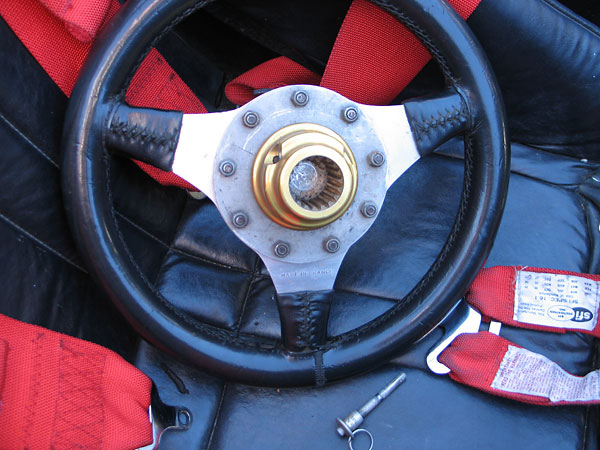
�
A pip pin secures the quick release steering wheel hub. This style is no longer available because some
�
race sanctioning organizations feel it is less safe. The steering wheel is marked "Made in France".
�
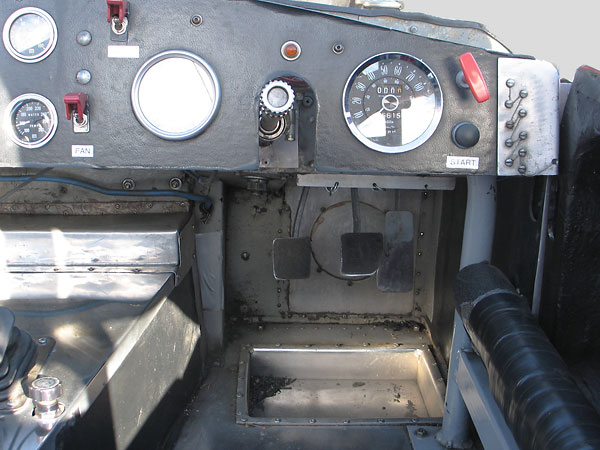
�
The transmission tunnel cover is removeable for convenient access for maintenance and repairs.
�
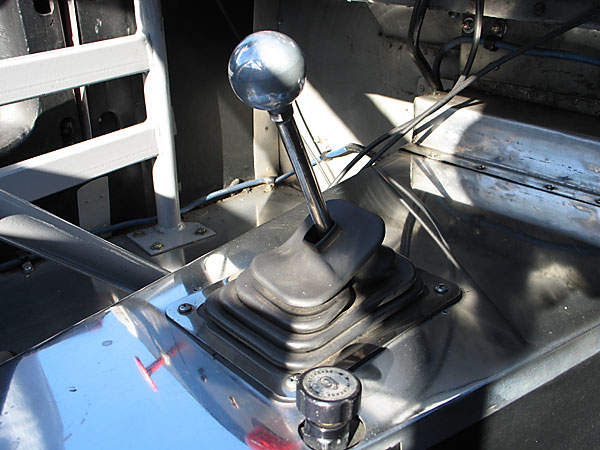
�
An adjustable brake proportioning valve remains where it was installed for SCCA racing.
�
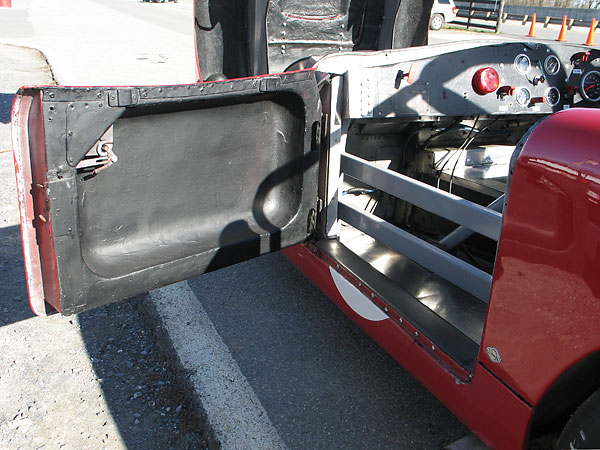
�
Lightweight fiberglass doors.
�
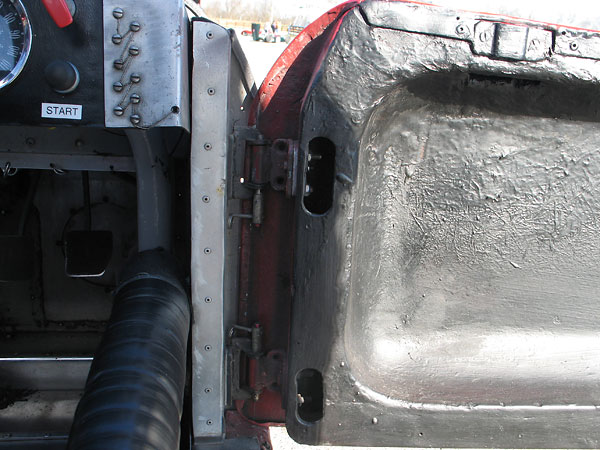
�
The doors are easily removeable because quick release "pip pins" have been used as hinge pins.
�
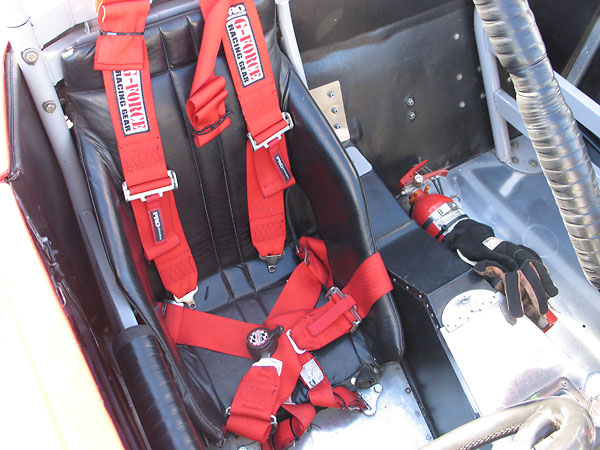
�
G-force six point cam-lock safety harness.
�
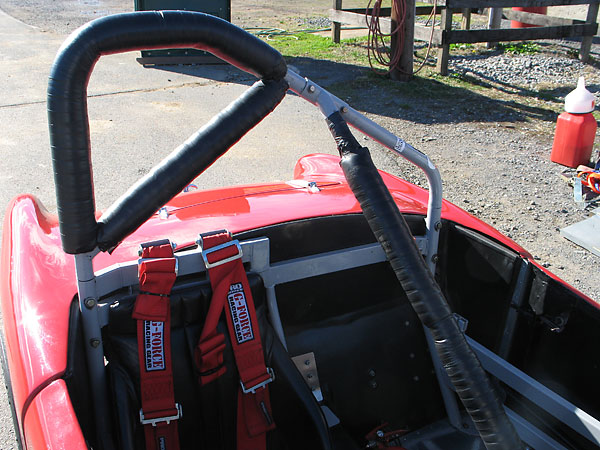
�
Shoulder strap mounting brackets.
�
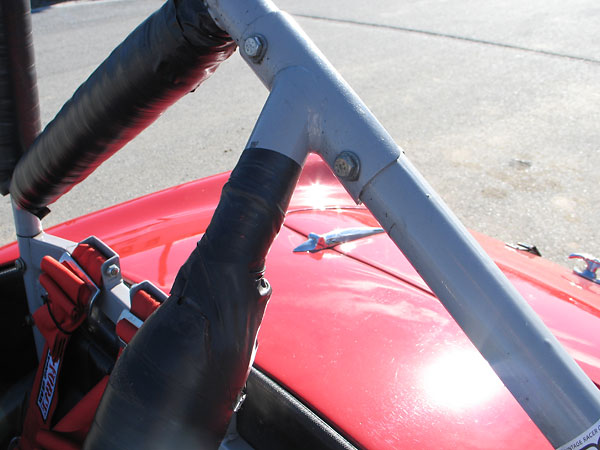
�
Upper mounting point of the removeable Petty bar.
�
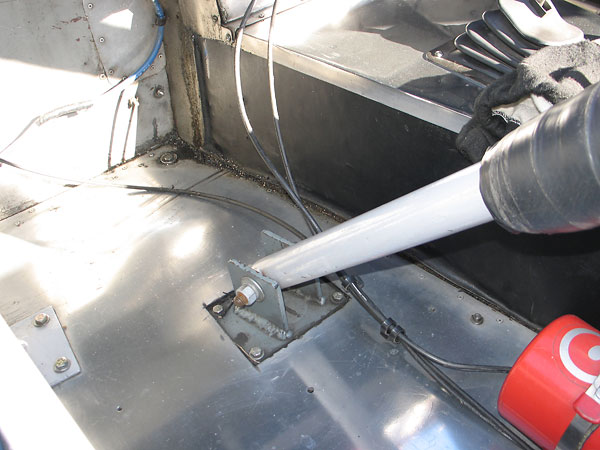
�
Lower mounting bracket of the removeable Petty bar.
�
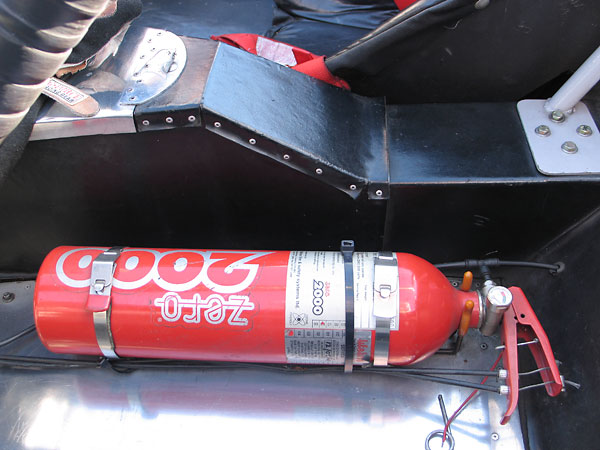
�
The Lifeline "Zero 2000" foam-extenguishant centralized fire suppression system has been
�
installed with two different cable-operated switches, one at either end of the dashboard.
�
�
Exterior
��
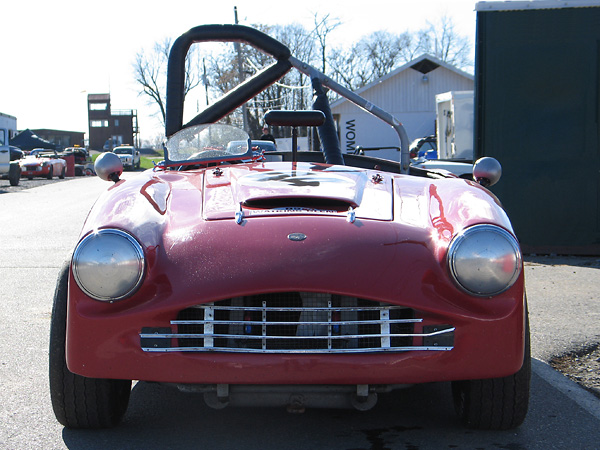
�
A little bit of negative camber.
�
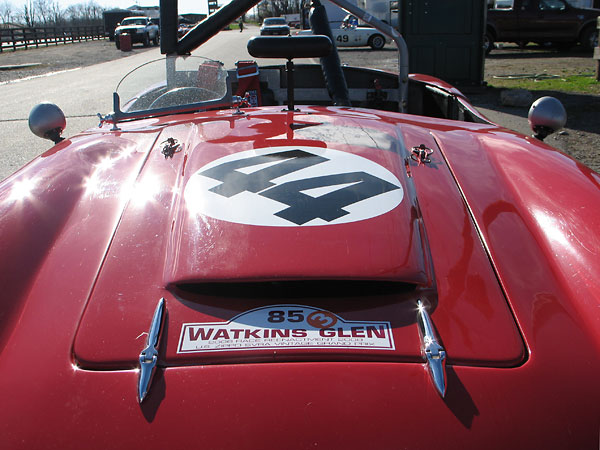
�
One distinguishing styling feature of the MkIII was its forward-facing hood scoop.
�
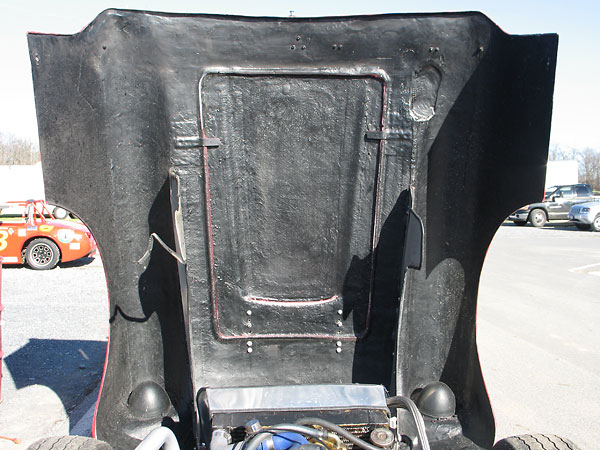
�
A major modification: the entire front half of the body hinges up for improved engine access.
�
This is very unusual. Larry Moulton's multi-championship winning MkIII didn't have this feature.
�
The Turner works race team's cars, back in the early sixties, didn't have this feature either.
�
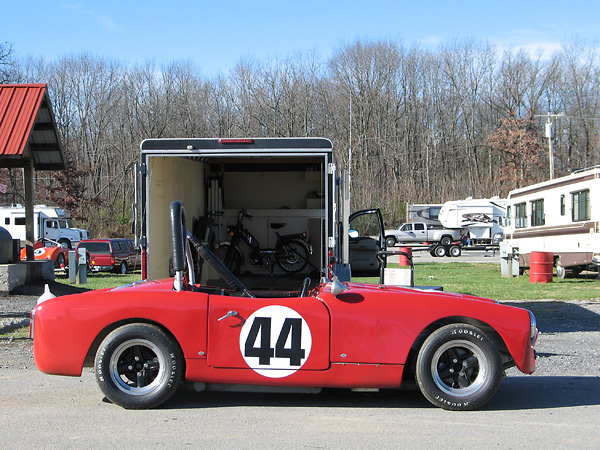
�
In this view you can see the Dzus fasteners that hold the front and rear body halves down.
�
(Hood pins or hold-down straps would be a worthwhile addition, especially for the rear clip!)
�
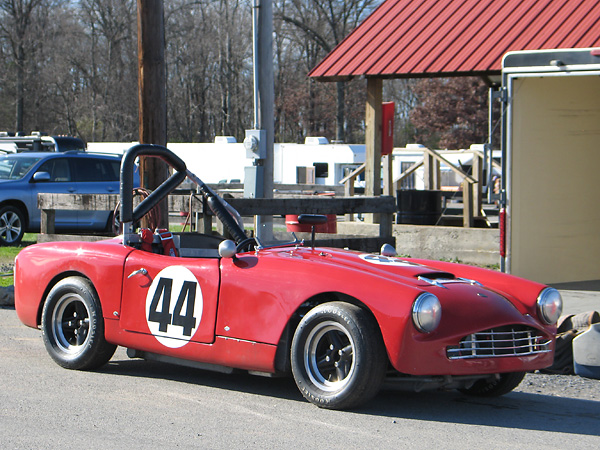
�
Turner built true sports cars. They weren't for sissies. If you care a lot about wind noise
�
warmth, staying dry on a rainy day... If you care at all about fancy trim, you needn't apply.
�
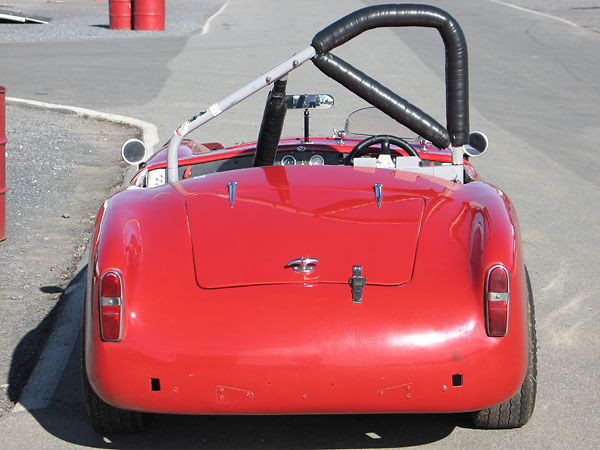
�
Turner Sports Cars had an excellent reputation for the quality of their fiberglass panels.
�
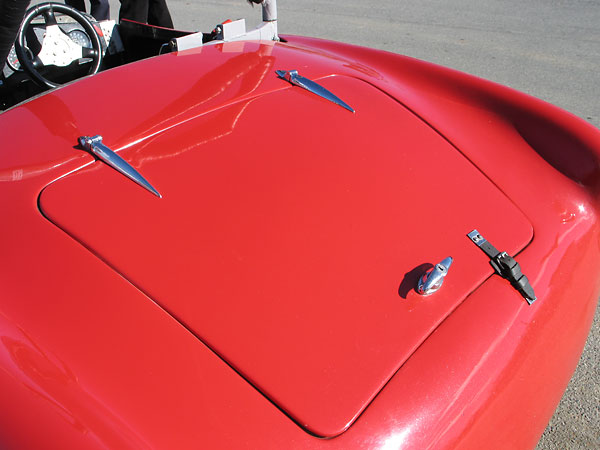
�
Alignment of bonnet and boot lids on this example are remarkably good despite its long racing history.
�
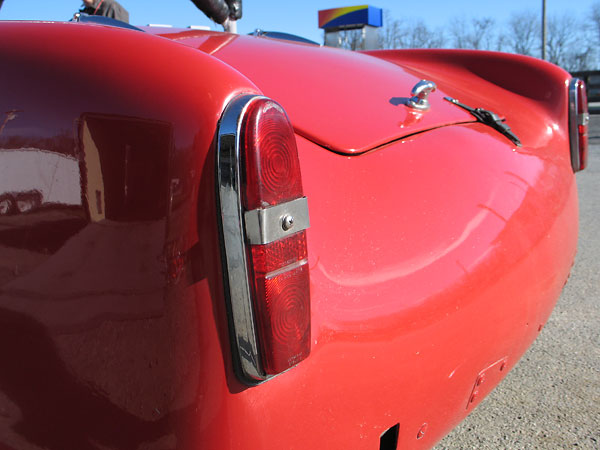
�
Apparently Turner switched between two different styles of taillight on the MkIII model.
�
This style, with truncated bottom, is from the Hillman Minx. The other popular taillight
�
was from Sunbeam Alpine/Tiger, and has a longer and more oval shape.
�
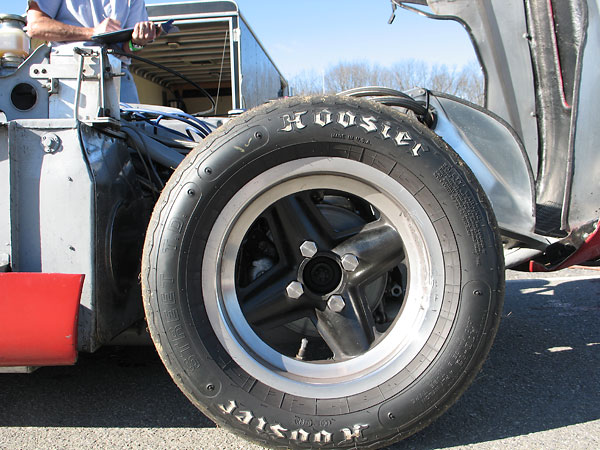
�
Revolution 13x6 aluminum wheels.
�
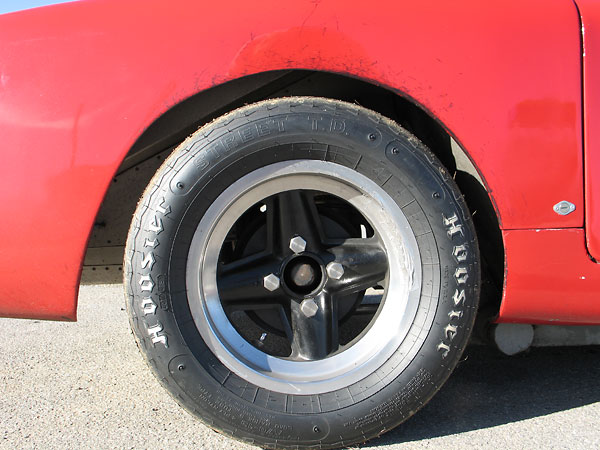
�
Hoosier Street T.D. A70-13 tires.
�
�
All photos shown here are from November 2009 when we viewed the car at VRG's Turkey Bowl�
at Summit Point Motorsports Park, West Virginia. Photos by Curtis Jacobson for BritishRaceCar.com, �
copyright 2010. All rights reserved.
�
| If you liked this article, you'll probably also enjoy these: | �|||||
 | �
Paul Bova '59 Turner Mk1 | �
 | �
Craig Chima '64 Ginetta G4 | �
Nick Chamberlain '65 A-H Sprite | �
|
| You're invited to discuss anything you've seen here on The British Racecar Motorsports Forum! | �|||||
�
Notice: all the articles and almost all the photos on BritishRacecar.com are by Curtis Jacobson.
�
(Photos that aren't by Curtis are explicitly credited.) Reproduction without prior written permission is prohibited.
�
Contact us to purchase images or reproduction permission. Higher resolution images are optionally available.
�

 �
�